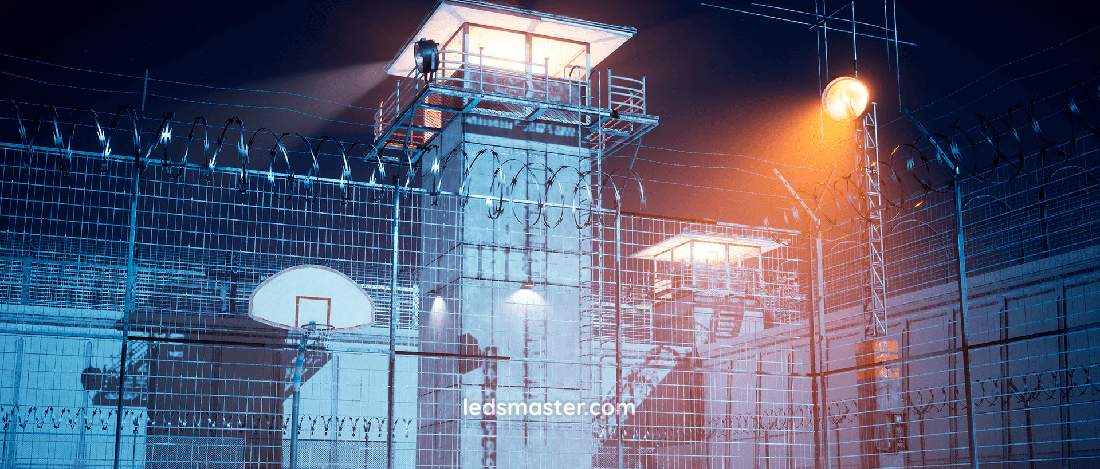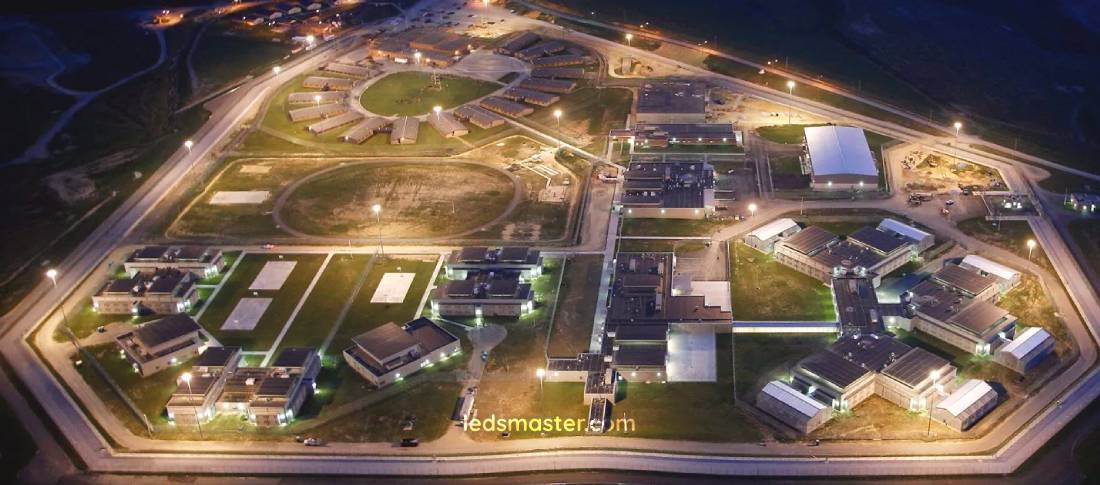Beyond mere visibility, effective lighting systems act as deterrents to potential threats while also fostering a sense of security within these often challenging settings. Recent advancements in LED technology have not only enhanced durability and energy efficiency but have also revolutionized how facilities approach lighting design.
The design and implementation of effective lighting systems are essential to creating an environment that promotes safety while also supporting rehabilitation efforts. In these often-challenging environments, the right lighting not only enhances visibility but also acts as a deterrent against potential threats, thereby fostering a sense of security.
Get your complimentary lighting design today
Table of Contents
ToggleIn the realm of correctional facilities, the emphasis on safety and security is paramount. The lighting system must deliver clear visibility for various stakeholders, including surveillance cameras, security personnel, and inmates. This visibility is not merely about illumination but also about preventing potential security breaches that could lead to dangerous situations.
A major consideration in this context is the need for tamper-proof and vandalism-resistant lighting fixtures. High-risk areas often employ bullet-proof lighting covers, typically constructed from robust materials such as polycarbonate or specialized metals. These materials are designed to withstand impacts and maintain operational functionality even in high-stress environments. Such features enhance the resilience of the lighting system, ensuring it can endure the challenges posed by the facility’s unique context.

The ability of lighting fixtures to endure tampering or vandalism is vital. Inmates may attempt to manipulate or destroy lighting for various reasons, including creating shadows or blind spots that could be exploited. Therefore, lighting systems must be fortified not only to deter physical damage but also to maintain a continuous flow of visibility throughout the facility. By ensuring that all lighting fixtures are resistant to tampering, facilities can enhance their overall security framework.
Regular monitoring of lighting conditions is also essential. This can involve periodic inspections to assess the functionality of fixtures and ensure they meet safety standards. Automated systems can provide real-time feedback about lighting performance, allowing facilities to promptly address any issues that may arise, thus maintaining optimal safety levels.
The durability of lighting systems in correctional facilities is a fundamental characteristic that cannot be overlooked. These fixtures are subject to frequent vibrations, potential impacts, and harsh environmental conditions.
Lighting systems must perform reliably over extended periods without compromising their functionality. In this regard, LED lighting has emerged as a favored option. Known for its durability and extended lifespan, LED technology can withstand shocks and vibrations, making it ideal for correctional environments. Additionally, LED fixtures are energy-efficient, further contributing to the facility’s operational sustainability.
A significant advantage of LED fixtures is their ability to reduce maintenance intervals. Traditional lighting solutions often require frequent replacements and repairs, diverting staff time and resources. LED technology minimizes these demands, allowing maintenance staff to focus on other critical tasks within the facility.
Establishing streamlined maintenance protocols can enhance the overall reliability of the lighting system. By implementing routine inspections and maintenance schedules, facilities can ensure that their lighting remains functional and safe, ultimately reducing the likelihood of unexpected outages that could compromise security.

When it comes to designing lighting layouts in correctional facilities, there is a delicate balance between addressing security requirements and fostering a supportive environment for occupants.
A uniform distribution of lighting is necessary to minimize shadows, which can create hiding spots and diminish visibility throughout the facility. Strategically placed fixtures in critical areas such as corridors, cells, and common areas can significantly enhance surveillance capabilities while simultaneously promoting a safe atmosphere for all individuals present.
Incorporating elements of natural light into the design can also be beneficial. Skylights and windows, when positioned correctly, can enhance the overall lighting quality within the facility while reducing reliance on artificial lighting. This natural illumination can create a more inviting atmosphere and improve the psychological well-being of inmates and staff alike.
In addition to regular lighting, integrating emergency lighting systems into the design is crucial. These systems should be strategically placed to ensure that essential areas remain illuminated during power failures or emergencies. This design consideration not only supports safety protocols but also provides peace of mind to both staff and inmates.
Correctional facilities encompass a range of specialized areas that come with unique lighting requirements.
Medical units, for instance, necessitate adjustable lighting that can accommodate the intricacies of medical procedures and ensure adequate patient care. This flexibility is vital not only for the functionality of medical staff but also for the well-being of inmates receiving treatment. The right lighting can support a variety of medical activities, from routine check-ups to emergency procedures.
Recreation areas, on the other hand, require lighting that can support diverse activities while still promoting a secure environment. Effective lighting in these spaces can facilitate various recreational programs and help reduce tensions among inmates. Additionally, consideration must be given to exterior lighting, which plays a significant role in deterring unauthorized access and enhancing perimeter surveillance. Care must be taken to avoid creating light pollution or glare that could compromise visibility for security personnel or interfere with the natural environment surrounding the facility.
Administrative areas also require specialized lighting solutions. These spaces often need a combination of task lighting and ambient lighting to create a comfortable working environment for staff. Proper illumination in these areas can enhance productivity and contribute to overall staff satisfaction, which is crucial in the high-pressure environment of a correctional facility.
The focus on energy efficiency in correctional facilities is becoming increasingly relevant. By optimizing energy use, facilities can not only reduce operational costs but also minimize their environmental impact.
LED technology stands out in this regard, offering substantial energy savings compared to traditional lighting options. This aligns well with sustainability goals by lowering carbon emissions and decreasing the frequency of maintenance interventions. The long lifespan of LED fixtures ensures that replacement cycles are extended, contributing to a reduction in waste and further enhancing sustainability efforts.
Furthermore, the integration of smart lighting controls offers a sophisticated solution for managing energy consumption. These systems can automate scheduling, incorporate occupancy sensing, and enable remote monitoring, all of which contribute to optimizing energy use. Such advancements ensure that the lighting system operates efficiently without compromising the security or operational requirements of the facility. By embracing these energy-efficient practices, correctional facilities can demonstrate a commitment to sustainability while enhancing overall operational effectiveness.
Regulatory compliance is an integral component of lighting design in correctional facilities. Adherence to safety standards and regulations is non-negotiable, as these guidelines help ensure the protection of both staff and inmates.
Lighting fixtures must meet rigorous standards concerning durability, fire resistance, and electrical safety. Many manufacturers go to great lengths to certify their products, ensuring that they comply with relevant codes and regulations. This certification provides assurance of the quality and reliability of the lighting solutions deployed in demanding environments.
Furthermore, facilities must remain vigilant in staying updated on changes to regulations and standards. As codes evolve, corrections may be required to lighting systems to maintain compliance and ensure ongoing safety. Regular audits and assessments of the lighting infrastructure can help identify areas for improvement, allowing for timely upgrades that keep the facility aligned with current standards.
The integration of lighting systems with existing security protocols is essential for enhancing the overall security framework of correctional facilities.
A well-designed lighting system must function cohesively with other critical components, including CCTV cameras, access control systems, and alarm systems. This collaborative approach creates a comprehensive security solution that addresses the unique challenges faced within these environments. For instance, lighting fixtures equipped with motion sensors can react dynamically to movements, thereby improving the facility’s surveillance capabilities.
By illuminating areas where movement is detected, these sensors enhance the ability of security personnel to monitor activities and identify potential threats in real time. In addition to motion sensors, advanced lighting systems can be programmed to interact with other security measures. For example, if an access control system detects unauthorized entry into a restricted area, it can trigger the lighting system to increase brightness in that location, drawing immediate attention to the breach. This integration allows for quicker response times, enabling staff to act promptly in mitigating any potential security incidents.
Emergency lighting features also play a significant role in supporting rapid response protocols during incidents or power outages.
In the event of an emergency, such as a disturbance or fire, it is crucial for essential areas—like control rooms, medical units, and evacuation routes—to remain illuminated. Emergency lighting systems are designed to activate automatically during power failures, ensuring that these vital areas remain lit even when standard power sources fail. This continuous illumination not only aids staff in navigating the facility during crises but also provides a sense of security for inmates who may feel anxious or vulnerable in such situations.
Furthermore, emergency lighting is often accompanied by backup power sources, such as batteries or generators, which ensure reliability when the facility is most in need. The presence of well-illuminated escape routes and emergency exits can significantly improve the efficiency of evacuation procedures, facilitating a smoother and safer exit during critical situations. By maintaining visibility in these scenarios, correctional facilities can enhance their overall emergency response strategies while contributing to a sense of stability and safety for both staff and inmates during unforeseen circumstances.
Beyond mere functionality, the design of lighting in correctional facilities has a profound impact on the psychological well-being of inmates and staff.
Research suggests that exposure to natural light and thoughtfully designed lighting schemes can support the maintenance of circadian rhythms, promoting better sleep patterns. A calm and predictable lighting environment can help alleviate stress levels, which is beneficial for both staff and inmates.
By fostering a supportive environment, facilities can enhance the potential for positive behavior management and rehabilitation. Incorporating elements of natural daylight simulation into the lighting design can create a more inviting atmosphere that aids in reducing feelings of confinement. Such holistic approaches not only reinforce security measures but also contribute to the overarching goal of rehabilitation, creating a safer and more conducive environment for personal growth and change.
Moreover, strategic design considerations, along with specialized lighting for different areas, help to optimize both security and energy efficiency.
Facilities must remain diligent in adhering to stringent regulations and integrating lighting systems seamlessly with existing security frameworks. By addressing these multifaceted needs, correctional facility lighting systems can enhance safety measures while simultaneously supporting rehabilitation efforts. This approach contributes to a safer and more rehabilitative environment for both inmates and staff.
The lighting solutions implemented in correctional facilities play a vital role in ensuring safety and security while simultaneously promoting a supportive atmosphere conducive to rehabilitation. The integration of durable, tamper-proof lighting fixtures, including protective covers where warranted, directly addresses the unique security challenges inherent to these environments. The adoption of LED technology enhances operational efficiency by providing a long-lasting and low-maintenance lighting solution. Furthermore, thoughtful design and advanced technology integration can create environments that support not just security needs but also the well-being of all individuals within these facilities.